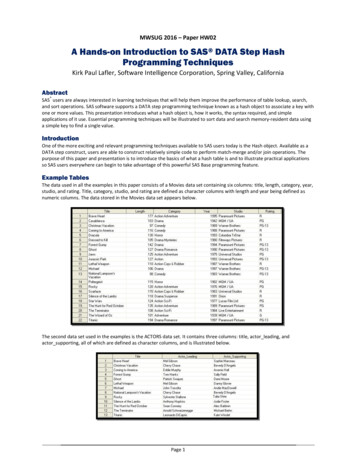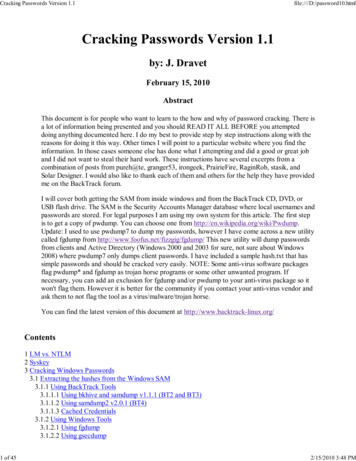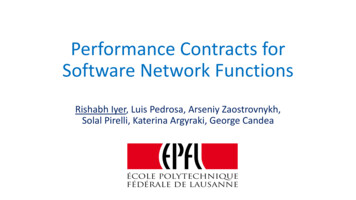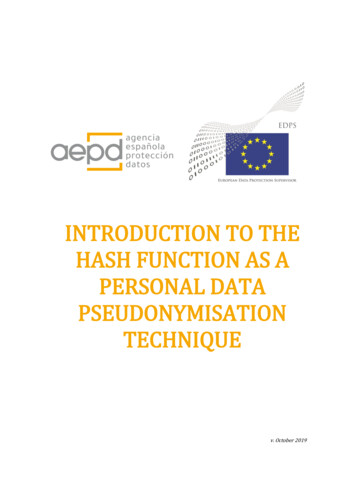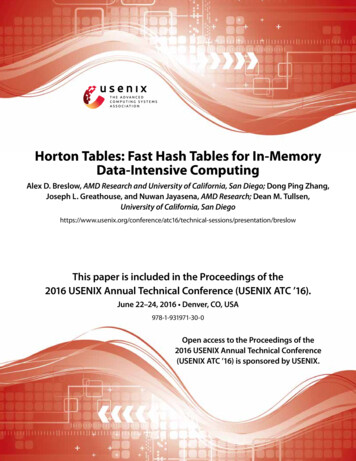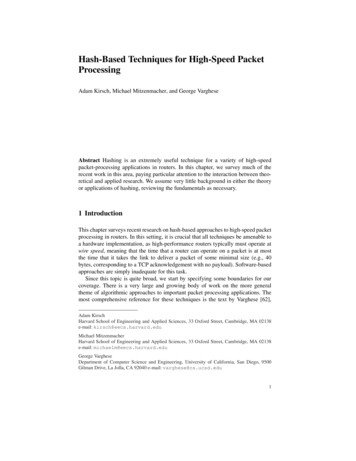
Transcription
Hash-Based Techniques for High-Speed PacketProcessingAdam Kirsch, Michael Mitzenmacher, and George VargheseAbstract Hashing is an extremely useful technique for a variety of high-speedpacket-processing applications in routers. In this chapter, we survey much of therecent work in this area, paying particular attention to the interaction between theoretical and applied research. We assume very little background in either the theoryor applications of hashing, reviewing the fundamentals as necessary.1 IntroductionThis chapter surveys recent research on hash-based approaches to high-speed packetprocessing in routers. In this setting, it is crucial that all techniques be amenable toa hardware implementation, as high-performance routers typically must operate atwire speed, meaning that the time that a router can operate on a packet is at mostthe time that it takes the link to deliver a packet of some minimal size (e.g., 40bytes, corresponding to a TCP acknowledgement with no payload). Software-basedapproaches are simply inadequate for this task.Since this topic is quite broad, we start by specifying some boundaries for ourcoverage. There is a very large and growing body of work on the more generaltheme of algorithmic approaches to important packet processing applications. Themost comprehensive reference for these techniques is the text by Varghese [62],Adam KirschHarvard School of Engineering and Applied Sciences, 33 Oxford Street, Cambridge, MA 02138e-mail: kirsch@eecs.harvard.eduMichael MitzenmacherHarvard School of Engineering and Applied Sciences, 33 Oxford Street, Cambridge, MA 02138e-mail: michaelm@eecs.harvard.eduGeorge VargheseDepartment of Computer Science and Engineering, University of California, San Diego, 9500Gilman Drive, La Jolla, CA 92040 e-mail: varghese@cs.ucsd.edu1
2Adam Kirsch, Michael Mitzenmacher, and George Varghesepublished in 2004. We therefore focus our attention on work done since then. Evenlimiting ourselves to the relevant research in the last few years, however, would leavean enormous number of papers to cover! We therefore further focus our attentionon two key application areas for high-speed routers: hash tables and related datastructures, and hash-based schemes for network measurement. While we aim to becomprehensive, given the huge recent growth of interest in this area, this surveyshould be considered a guide to the literature rather than a full account.Before diving into the literature, we offer some of our high-level perspective thatguides this survey. First, as will become apparent in the body of this chapter, thereis an enormous amount of potential for interplay between theoretical and appliedtechniques. It follows that the relevant literature spans the spectrum from very theoretical to very applied. We aim our attention on the middle of this range, but weemphasize that any particular piece of work must be considered relative to its placein the spectrum. For instance, when we discuss hash table designs for high-speedrouters, we consider several theoretical papers that focus on the design of hash tables generally, rather than on some particular application. In such work, the primarygoal is often to present and evaluate general data structure design principles thatappear to have broad potential to impact the implementation of practical systems.The evaluation in these works usually takes the form of establishing various guarantees on the data structure outside the context of any particular application. Forexample, a work in this vein that proposes a novel hash table design may place significant emphasis on the sorts of theoretical and numerical guarantees that can beobtained under the new design, with simulations serving in a mostly supporting role.Naturally, then, a major challenge in this area is to design data structures that areamenable to a compelling evaluation of this sort. Of course, since this approach isvery general, it typically does not speak directly to how such a data structure mightperform when appropriately adjusted and implemented in a real application. Whenproperly interpreted, however, the results of these more theoretical works can behighly suggestive of increased performance for a broad range of settings.Similarly, very applied works should be considered with respect to the concreteresults that they demonstrate for the specific application of interest. And, of course,works in the middle of the spectrum typically should be considered with respect tosome combination of these goals, for instance showing that a particular theoreticalintuition seems to lead to compelling results for some class of related applications.In the rest of the survey, we first give the necessary background and historyin Section 2. We then consider three fairly broad application settings: hash tablelookups for various hardware memory models (Sections 3 and 4), Bloom filter-typeapplications (Section 5), and network measurement (Section 6).2 BackgroundWe review some of the key concepts underlying the hash-based data structures commonly proposed for high-speed packet processing. We describe the performance
Hash-Based Techniques for High-Speed Packet Processing3measures relevant to these applications and the resulting hardware models, and alsogive a brief history of the earlier literature on these applications.2.1 Hash-Based Data StructuresWe begin with a brief review of the relevant history, constructions, and issues in thedesign of hash-based data structures. We describe some of the tension between thetheory an practice of hash functions that informs our analyses, review the standardBloom filter data structure and its variants, and discuss multiple-choice hash tables.2.1.1 Hash FunctionsIntuitively, a hash function h : U V is a function that maps every item u Uto a hash value h(u) V in a fashion that is somehow random. The most naturalmathematical model for a hash function is that it is fully random; that is, it is arandom element of V U , the set of functions with domain U and codomain V . Underthis assumption, the hash values {h(x) : x U} corresponding to the items in U areindependent random variables that are each uniformly distributed over V . Clearly,this is a very appealing scenario for probabilistic analysis.Unfortunately, it is almost always impractical to construct fully random hashfunctions, as the space required to store such a function is essentially the same asthat required to encode an arbitrary function in V U as a lookup table. From a theoretical perspective, this sort of thinking quickly leads to compromises between therandomness properties that we desire in a hash function and the computational resources needed to store and evaluate such a function. The seminal work along theselines is the introduction of universal hash families by Carter and Wegman [9, 67],which introduces the idea of choosing a hash function h randomly (and efficiently)from a set H of potential hash functions, chosen so that the joint distribution ofthe random variables {h(x) : x U} satisfies limited but intuitively powerful properties. As a matter of terminology, the terms hash functions and hash families areoften used interchangeably when the meaning is clear.Specifically, a family of hash functions H with domain U and codomain V issaid to be 2-universal if, for every pair of distinct items x, y U, we have that for aproperly sampled hash function h H ,Pr(h(x) h(y)) 1. V That is, the probability of a collision between any pair of items after being hashedis at most that for a fully random hash function. A family of hash functions is saidto be strongly 2-universal, or more commonly in modern terminology pairwise independent, if for every pair of distinct items x, y U and any x0 , y0 V , we have
4Adam Kirsch, Michael Mitzenmacher, and George VarghesePr(h(x) x0 and h(y) y0 ) 1. V 2That is, the behavior for any pair of distinct items is the same as for a fully random hash function. Historically, in some cases the term universal is used whenstrongly universal is meant. Pairwise independence generalizes naturally to k-wiseindependence for collections of k items, and similarly one can consider k-universalhash functions, although generally k-wise independence is more common and useful. More information can be found in standard references such as [46].Since Carter and Wegman’s original work [9], there has been a substantialamount of research on efficient constructions of hash functions that are theoretically suitable for use in data structures and algorithms (e.g., [48, 55] and referencestherein). Unfortunately, while there are many impressive theoretical results in thatliterature, the constructed hash families are usually impractical. Thus, at least atpresent, these results do not seem to have much potential to directly impact a realimplementation of hash functions.Fortunately, it seems that in practice simple hash functions perform very well.Indeed, they can be implemented very efficiently. For example, Dietzfelbinger etal. [18] exhibit a hash function that can be implemented with a single multiplicationand a right shift operation and is almost universal. For scenarios where multiplications are undesirable, Carter and Wegman’s original work [9] provides a universalhash function that relies on XOR operations. Some practical evaluations of thesehash functions and others, for both hardware and software applications (includingBloom filters, discussed in Section 2.1.2), are given in [24,52–54,59]. Overall, theseworks suggest that it is possible to choose very simple hash functions that work verywell in practical applications.There is also theoretical work that strives to explain why simple hash functionsseem to perform well in practice. One common approach is to examine a particular theoretical analysis that uses the assumption of fully random hash functions,and then attempt to modify the analysis to obtain a comparable result for a class ofsimple hash functions (e.g., universal hash functions), or a particular family of hashfunctions. For instance, it is an easy exercise to show that partitioned Bloom filters(described in Section 2.1.2) can be implemented with any universal hash function,albeit with a small increase in the false positive probability. As an example of thistechnique that works only for a specific hash family, Woelfel [68] shows that onecan implement d-left hashing (described in Section 2.1.3) using a particular type ofsimple hash function. In a different direction, Mitzenmacher and Vadhan [47] showthat for certain applications, if one is willing to assume that the set of items beinghashed satisfies certain randomness properties, then any analysis based on the assumption that the hash functions are fully random is also valid with universal hashfunctions (up to some small, additional error probability). From a practical perspective, this work shows that it may be possible to construct some sort of statisticaltest that would provide a theoretical explanation for how well applications built onsimple hash functions will work on a particular source of real data. Alternatively, ifone is willing to assume that the set of items being hashed has a certain amount of
Hash-Based Techniques for High-Speed Packet Processing5entropy, then one can expect the same performance as derived from an analysis withfully random hash functions.Having reviewed the approaches to hashing most related to this work, we now articulate our perspective on hash functions. This is essentially just the standard viewin the networking literature, but it bears repeating. Since we are primarily concernedwith real-world systems, and since it is usually possible to choose a simple, practical hash function for an application that results in performance similar to what wewould expect for a fully random hash function, we allow ourselves to assume thatour hash functions are fully random in our theoretical analyses. Thus, we take theperspective of modeling the hash functions for the sake of predicting performancein a statistical sense, as opposed to explicitly constructing the hash functions to satisfy concrete theoretical guarantees. Furthermore, since we assume that simple hashfunctions work well, we generally do not think of the cost of hashing as a bottleneck,and so we often allow ourselves to use hash functions liberally.2.1.2 Bloom Filters and Their VariantsA Bloom filter [2] is a simple space-efficient randomized data structure for representing a set in order to support membership queries. We begin by reviewing thefundamentals, based on the presentation of the survey [7], which we refer to forfurther details. A Bloom filter for representing a set S {x1 , x2 , . . . , xn } of n itemsfrom a large universe U consists of an array of m bits, initially all set to 0. The filteruses k independent (fully random) hash functions h1 , . . . , hk with range {1, . . . , m}.For each item x S, the bits hi (x) are set to 1 for 1 i k. (A location can be setto 1 multiple times.) To check if an item y is in S, we check whether all hi (y) are setto 1. If not, then clearly y is not a member of S. If all hi (y) are set to 1, we assumethat y is in S, and hence a Bloom filter may yield a false positive.The probability of a false positive for an item not in the set, or the false positiveprobability, can be estimated in a straightforward fashion, given our assumptionthat the hash functions are fully random. After all the items of S are hashed into theBloom filter, the probability that a specific bit is still 0 isp0 (1 1/m)kn e kn/m .In this section, we generally use the approximation p e kn/m in place of p0 forconvenience.If ρ is the proportion of 0 bits after all the n items are inserted in the Bloom filter,then conditioned on ρ the probability of a false positive is³ k(1 ρ )k (1 p0 )k (1 p)k 1 e kn/m .These approximations follow since E[ρ ] p0 , and ρ can be shown to be highly concentrated around p0 using standard techniques. It is easy to show that the expression¡ k1 e kn/m is minimized when k ln 2 · (m/n), giving a false positive probability
6f ofAdam Kirsch, Michael Mitzenmacher, and George Varghese³ kf 1 e kn/m (1/2)k (0.6185)m/n .In practice, k must be an integer, and a smaller, sub-optimal k might be preferredsince this reduces the number of hash functions that have to be computed.This analysis provides us (roughly) with the probability that a single item z /Sgives a false positive. We would like to make a broader statement, that in fact thisgives a false positive rate. That is, if we choose a large number of distinct items notin S, the fraction of them that yield false positives is approximately f . This resultfollows immediately from the fact that ρ is highly concentrated around p0 , and forthis reason, the false positive probability is often referred to synonymously as thefalse positive rate. (However, note that if we choose a large number of items not in Sthat may contain repeats, the repeated items may cause the number of false positivesto exceed the predicted rate.)Before moving on, we note that sometimes Bloom filters are described slightlydifferently, with each hash function having a disjoint range of m/k consecutive bitlocations instead of having one shared array of m bits. We refer to this variant as apartitioned Bloom filter. Repeating the analysis above, we find that in this case theprobability that a specific bit is 0 is¶µk n e kn/m ,1 mand so, asymptotically, the performance is the same as the original scheme. In practice, however, the partitioned Bloom filter tends to perform slightly worse than thenon-partitioned Bloom filter. This is explained by the observation thatµµ¶¶k n1 kn 1 1 mmwhen k 1, so partitioned filters tend to have more 1’s than non-partitioned filters,resulting in larger false positive probabilities.The standard Bloom filter naturally supports insertion operations: to add a newitem x to the set represented by the filter, we simply set the corresponding bits ofthe filter to 1. Unfortunately, the data structure does not support deletions, sincechanging bits of the filter from 1 to 0 could introduce false negatives. Of course,if we wish to support deletions, we can simply replace each bit of the filter witha counter, initially set to 0. In this case, the filter naturally represents a multi-set Sof items, rather than a set. To insert an item x into the filter, we now increment itscorresponding counters h1 (x), . . . , hk (x), and to delete an item known to be in themulti-set represented by the filter, we decrement those counters. To test whether anitem y is in S, we can simply check whether all the counters h1 (y), . . . , hk (y) arepositive, obtaining a false positive if y 6 S but none of the counters are 0. (Moregenerally, we can test whether an item y occurs in S with multiplicity at least 1
Hash-Based Techniques for High-Speed Packet Processing7by testing whether the counters h1 (y), . . . , hk (y) are at least , with some probabilityof a false positive.)This Bloom filter variant is called a counting Bloom filter [24]. Clearly, all of ourprior analysis for standard Bloom filters applies to counting Bloom filters. However, there is a complication in choosing the number of bits to use in representing acounter. Indeed, if a counter overflows at some point, then the filter may yield a falsenegative in the future. It is easy to see that the number of times a particular counter isincremented has distribution Binomial(nk, 1/m) Poisson(nk/m) Poisson(ln 2),by the Poisson approximation to the binomial distribution (assuming k (m/n) ln 2as above). By a union bound, the probability that some counter overflows if we useb-bit counters is at most mPr(Poisson(ln 2) 2b ). As an example, for a sample configuration with n 10000, m 80000, k (m/n) ln 2 8 ln 2, and b 4, we havef (1/2)k 2.14% and mPr(Poisson(ln 2) 2b ) 1.78 10 11 , which is negligible. (Of course, in practice k must be an integer, but the point is clear.) This sortof calculation is typical for counting Bloom filters.We now describe a variant of counting Bloom filters that is particularly useful forhigh-speed data stream applications. The data structure is alternately called a parallel multistage filter [22] or a count-min sketch [12] ( [22] applies the data structureto network measurement and accounting, while [12] shows how it can be used tosolve a number of theoretical problems in calculating statistics for data streams).The input is a stream of updates (it , ct ), starting from t 1, where each item it is amember of a universe U {1, . . . , n}, and each count ct is an integer. The state ofthe system at time T is given by a vector a(T ) (a1 (T ), . . . , an (T )), where a j (T )is the sum of all ct for which t T and it j. The input is typically guaranteedto satisfy the condition that a j (T ) 0 for every j and T . We generally drop the Twhen the meaning is clear.The structures consists of a two-dimensional array Count of counters with widthw and depth d: Count[1, 1], . . . , Count[d, w]. Every entry of the array is initializedto 0. In addition, there are d independent hash functions h1 , . . . , hd : {1, . . . , n} {1, . . . , w}. (Actually, it is enough to assume that the hash functions are universal,as shown in [12]; the argument below also holds with this assumption.) To processan update (i, c), we add c to the counters Count[1, h1 (i)], . . . , Count[d, hd (i)]. Furthermore, we think of âi min j {1,.,d} Count[ j, h j (i)] as being an estimate of ai .Indeed, it is easy to see that âi ai (using the assumption that a j 0 for every j).We now derive a probabilistic upper bound on âi . For j {1, . . . , d}, letXi, j ai0 .i0 6 i:h j (i0 ) h j (i)Since the hash functions are fully random, E[Xi, j ] kak/w, where kak k ak (theL1 norm of a, assuming all of the entries in a are nonnegative). Markov’s inequalitythen implies that for any threshold value θ 0, we have Pr(Xi, j θ ) kak/wθ .Now we note that âi ai min j 1,.,d Xi, j and use independence of the h j ’s to conclude that¶µkak dPr(âi ai θ ) .wθ
8Adam Kirsch, Michael Mitzenmacher, and George VargheseIn particular, if we fix some parameters ε , δ 0 and set w de/ε e, d dln(1/δ )e,and θ ε kak, then we obtainµ ¶ln(1/δ )1Pr(âi ai ε kak) δ.eIn essence, we have that âi is likely to be a fairly good estimate of ai as long as ai isnot too small.Under the assumption that all ct are nonnegative, we can optimize this data structure further using a technique called conservative updating [22]. The basic idea is tonever increment a counter more than is strictly necessary in order to guarantee thatâi ai . Formally, to process an update (i, c), we let c0 min j {1,.,d} Count[ j, h j (i)]and then set Count[ j, h j (i)] max(c c0 , Count[ j, h j (i)]) for j 1, . . . , d. In particular, a counter is not updated if it is already larger than the count associated withthe item, which is c0 (the minimum over all the counters associated with i before theupdate) plus the update value c. We define the estimate âi of ai as before. It is easyto see that we still have âi ai under this approach, but now the counters are notincremented as much. Intuitively, this technique further reduces the impact of smallitems on the estimates for large items. Experiments show that the improvement canbe substantial [22].A further variant of a Bloom filter extending the paradigm in a different directionis the Bloomier filter, which keeps a function value associated with each of the setitems, thereby offering more than set membership [10]. More specifically, for eachitem x in a set S, there can be an associated fixed r-bit value f (x) {1, . . . , 2r 1};the 0 value is meant for items not in S. Given any item x S, the Bloomier filtercorrectly returns f (x), and for any item y / S, the Bloomier filter should return 0.Here, a false positive occurs when y / S but the Bloomier filter returns a non-zerovalue. As shown in [10], a Bloomier filter can be implemented near-optimally usinga cascade of Bloom filters, although there are somewhat more complex constructions with better asymptotic performance.We emphasize that the performance of a Bloom filter does not depend at all onthe size of the items in the set that it represents (except for the additional complexity required for the hash functions for larger items). Thus, although Bloom filtersallow false positives, the space savings over more traditional data structures for setmembership, such as hash tables, often outweigh this drawback. It is therefore notsurprising that Bloom filters and their many variations have proven increasinglyimportant for many applications (see, for instance, the survey [7]). As just a partial listing of additional examples of the proliferation of Bloom filter variations,compressed Bloom filters are optimized to minimize space when transmitted [44],retouched Bloom filters trade off false positives and false negatives [20], and approximate concurrent state machines extend the concept of a Bloomier filter bytracking the dynamically changing state of a changing set of items [3]. Althoughrecently more complex but asymptotically better alternatives have been proposed(e.g., [4, 49]), the Bloom filter’s simplicity, ease of use, and excellent performance
Hash-Based Techniques for High-Speed Packet Processing9make it a standard data structure that is and will continue to be of great use in manyapplications.2.1.3 Hash TablesThe canonical example of a hash table is one that uses a single hash function (whichis assumed to be fully random) with chaining to deal with collisions. The standardanalysis shows that if the number of buckets in the table is proportional to the number of items inserted, the expected number of items that collide with a particularitem is constant. Thus, on average, lookup operations should be fast. However, forapplications where such average case guarantees are not sufficient, we also needsome sort of probabilistic worst case guarantee. Here, the qualifier that our worstcase guarantees be probabilistic excludes, for instance, the case where all items inthe table are hashed to the same bucket. Such situations, while technically possible,are so ridiculously unlikely that they do not warrant serious consideration (at leastfrom a theoretical perspective). As an example of a probabilistic worst case guarantee, we consider throwing n balls independently and uniformly at random into nbins. In this case, a classical result (e.g., [46, Lemmas 5.1 and 5.12] or the original reference by Gonnet [29]) shows that the maximum number of balls in a bin isΘ ((log n)/ log log n) with high probability. This result translates directly to a probabilistic worst case guarantee for a standard hash table with n items and n buckets:while the expected time to lookup a particular item is constant, with high probabilitythe longest time that any lookup can require is Θ ((log n)/ log log n).The previous example illustrates a connection between hashing and balanced allocations, where some number of balls is placed into bins according to some probabilistic procedure, with the implicit goal of achieving an allocation where the ballsare more-or-less evenly distributed among the bins. In a seminal work, Azar et al. [1]strengthened this connection by showing a very powerful balanced allocation result:if n balls are placed sequentially into m n bins for m O(n), with each ball beingplaced in one of a constant d 2 randomly chosen bins with minimal load at thetime of its insertion, then with high probability the maximal load in a bin after allballs are inserted is (ln ln n)/ ln d O(1). In particular, if we modify the standardhash table with chaining from above to use d hash functions, inserting an item intoone of its d hash buckets with minimal total load, and performing a lookup for anitem by checking all d of its hash buckets, then the expected lookup time is stillconstant (although larger than before), but the probabilistic worst case lookup timedrops exponentially. This scheme, usually called d-way chaining, is arguably thesimplest instance of a multiple choice hash table, where each item is placed according to one of several hash functions.Unsurprisingly, the impact of [1] on the design of randomized algorithms anddata structures, particularly hash tables and their relatives, has been enormous. Fordetails and a more complete list of references, we refer to the survey [45]. Beforemoving on, however, we mention an important improvement of the main results
10Adam Kirsch, Michael Mitzenmacher, and George Varghesein [1] due to Vöcking [65]. That work exhibits the d-left hashing scheme, whichworks as follows. There are n items and m buckets. The buckets are partitioned intod groups of approximately equal size, and the groups are laid out from left to right.There is one hash function for each group, mapping the items to a randomly chosenbucket in the group. The items are inserted sequentially into the table, with an itembeing inserted into the least loaded of its d hash buckets (using chaining), with tiesbroken to the left. Vöcking [65] shows that if m n and d 2 is constant, then themaximum load of a bucket after all the items are inserted is (ln ln n)/d φd O(1),where φd is the asymptotic growth rate of the d-th order Fibonacci numbers. Inparticular, this improves the factor of ln d in the denominator of the (ln ln n)/ ln d O(1) result of Azar et al. [1]. Furthermore, [65] shows that d-left hashing is optimalup to an additive constant. Interestingly, both the partitioning and the tie-breakingtogether are needed to obtain this improvement.Both d-way chaining and d-left hashing are practical schemes, with d-left hashing being generally preferable. In particular, the partitioning of the hash buckets intogroups for d-left hashing makes that scheme more amenable to a hardware implementation, since it allows for an item’s d hash locations to be examined in parallel.For high-speed packet processing applications, however, hashing schemes that resolve collisions with chaining are often undesirable. Indeed, for these applicationsit is often critical that almost everything be implemented cleanly in hardware, andin this case the dynamic memory allocation requirements of hashing schemes thatuse chaining are problematic. Thus, we prefer open-addressed hash tables whereeach bucket can store a fixed constant number of items (typically determined by thenumber of items that can be conveniently read in parallel). Of course, we can simulate a hashing scheme that uses chaining with an open-addressed hash table as longas no bucket overflows, and then we just need to ensure that it is highly unlikelyfor a bucket to overflow. Alternatively, we can work directly with open-addressedhashing schemes that are explicitly designed with a limit on the number of itemsthat can be stored in a bucket. In this case, for the sake of simplicity, we typicallyassume that each bucket can hold at most one item. The results can usually be generalized for larger buckets in a straightforward way. The potential expense of usingopen-addressed hash tables in these ways is that many buckets may be far from full,wasting significant space.The standard open-addressed multiple choice hash table is the multilevel hashtable (MHT) of Broder and Karlin [6]. This is a hash table consisting of d subtables T1 , . . . , Td , with each Ti having one hash function hi . We view these tables asbeing laid out from left to right. To insert an item x, we find the minimal i such thatTi [hi (x)] is unoccupied, and place x there. As above, we assume that each bucketcan store at most one item; in this case the MHT is essentially the same as a dleft hash table with the restriction that each bucket can hold at most one item, butthe correspondence disappears for larger bucket s
design of hash-based data structures. We describe some of the tension between the theory an practice of hash functions that informs our analyses, review the standard Bloom filter data structure and its variants, and discuss multiple-choice hash tables. 2.1.1 Hash Functions Intuitively, a hash function h: U ! V is a function that maps every .
